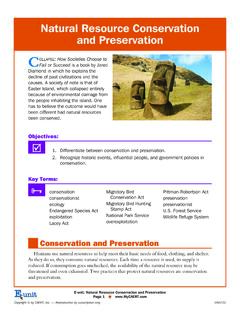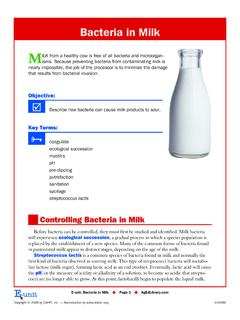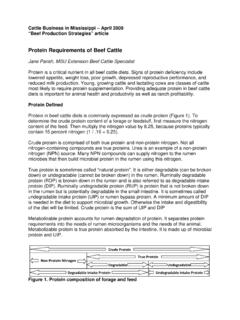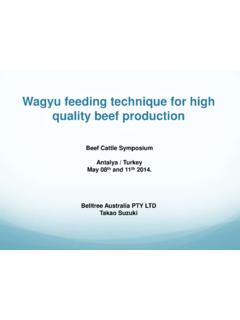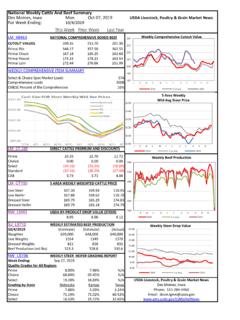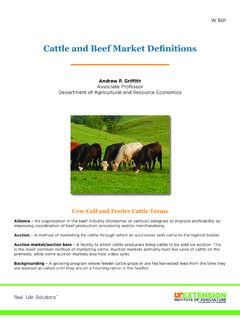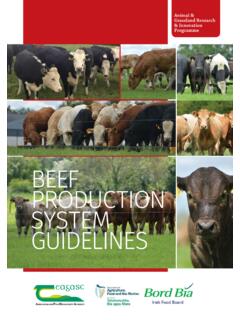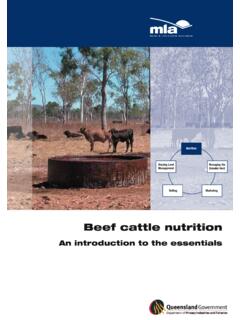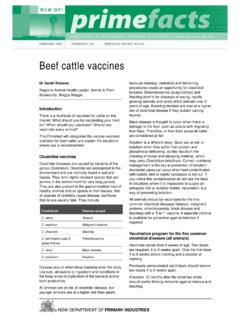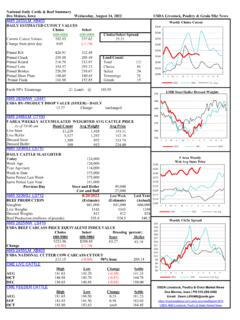Transcription of Types of Beef Cattle Operations— Part One
1 Types of beef Cattle operations Part OneBEEFis America s best-sellingprotein. As a result, beef cattleproduction represents the largest singlesegment of American agriculture. In2002, 31 percent of farms wereclassified as beef Cattle operations ,which was more than any other type ofproduction. In 2006, more than800,000 ranchers and Cattle producersworked in the United States. Learningthe Types of beef Cattle operationsprovides a greater appreciation for theworkers who provide you with steaksand : 1. Compare and contrast the components of cow-calf, backgrounding, andfinishing Examine the factors that affect Terms: background-stocker operationsbackgroundercommercialcow-calf operationscreep feedingcustom feedlotfinishing operationsseedstock breedersstockerE-unit: Types of beef Cattle operations Part OnePage by CAERT, Inc.
2 Reproduction by subscription Cattle SystemsSeveral methods are used to organize and classify the Types of beef production systems inthe United States. The most commonly used systems are cow-calf, backgrounding, and finish-ing OPERATIONSM ainly family owned and operated,cow-calf operationsinvolve keeping mature cattleto produce calves to sell to other producers. Cows are bred to have a calf every year, usually inlate winter or early spring. Although the cows and calves generally graze on large pastures,creep feeding(supplemental feeding) is used to allow calves to gain more weight whilenursing.
3 Generally, calves are weaned at 6 to 10 months of are two different general classifications of cow-calf operations . Thecommercialcow-calf producer raises most of the potential steers and heifers for harvest. The other type ofoperation is known asseedstock breeders. These producers keep herds for purebredbreeding stock and provide replacement bulls or semen for cow-calf of a cow-calfoperation include pasture ground,a few facilities for calving, feed,feed storage and handling, min-eral supplements, creep feedingsupplies and equipment, calf pro-cessing and loading facilities, anoffice, and cow-calf produc-ers utilize crossbred and a fewpurebred cows.
4 These producersrely on seedstock breeders for thereplacement of heifers and bulls. The focus of the seedstock breeder is to provide geneticimprovements for other Cattle breeders. The initial start-up cost for a seedstock breeder is rela-tively high because genetically superior animals are more expensive than average large investment is the time to develop high-quality CycleThe biology of the beef cow and the expectations of the beef industry are the two main fac-tors that cause the Cattle cycle. Like several livestock industries, the Cattle cycle takes a while torespond to increased demands for beef due to the gestation period of cows.
5 A replacementheifer may take three years to produce a harvested animal, which is why the Cattle businessE-unit: Types of beef Cattle operations Part OnePage by CAERT, Inc. Reproduction by subscription 1. Quality pasture ground is one of the several components of acow-calf be compared to a factoryindustry. Time, patience, andsound management/marketingprograms are crucial for acow-calf producer to understandthe Cattle oper-ationsare used to grow feedercattle. Some calves are too small/light to enter the feedlot, so astockeroperation utilizes a graz-ing program.
6 Abackgrounderwill usually grow the calves in adrylot where they receive feedwith a high roughage ration. Nor-mally Cattle are moved onto thefeedlot operation at 12 to 18months of age. Like the cow-calfoperation, background-stockeroperations are typically fam-ily-owned ranches and main goal of a back-ground-stocker operation is toproduce replacement Cattle for theherd or a mature animal for thefeedlot. Many Cattle are not physi-cally sound enough to enter afeedlot after systems, some-times called preconditioned pro-grams, grow the Cattle by addingframe but not fattening backgrounding opera-tions utilize pastures and openground for grazing or drylots.
7 AE-unit: Types of beef Cattle operations Part OnePage by CAERT, Inc. Reproduction by subscription 2. When a calf involved in a cow-calf operation is old enough, it willbe sold to another producer. (Courtesy, Gary and Pam Naylor, Missouri)FIGURE 3. Vaccinations help prevent disease. (Courtesy, Thunderbolt Angus)FIGURE 4. Background-stocker operations are usually set up on ranches andfarms owned by families. (Courtesy, Texas Department of Agriculture)stocker operation generally has a grazing program that uses different Types of grasses or othercereal grain forages, and a backgrounder usually will grow the calves in a drylot.
8 The maincomponents of a backgrounding operation include a pen, feedbunk, feed storage and handling,processing and loading facilities, an office, and OPERATIONSF eedlots look different than the first two beef systems operationsinvolve feedlots used to complete the final phase of the beef production system. Cattle are fedin fenced areas, and feed is brought to them. Some Cattle are finished on pasture. The cattletypically spend four to six months in a feedlot. They are fed to harvest weight, which is gener-ally between 1,100 to 1,300 pounds.
9 The feedlot operation can be owned by an individual orpartnership; more commonly, however, a corporation owns the feedlot operation especiallyas the feedlot size operations prepare beef animals for the harvest market. Owners usually buy yearlingsor feeder calves and try to finish them in as little time as possible. Yet some operations act as acustom feedlot, which is an operation that provides the technology, skills and services, facil-ities and location to a producer who wants Cattle fed to market weight. Many producers wantto retain the ownership of Cattle through harvest; others have a desire to feed out are carefully unloaded atthe feedlot and are directedthrough a processing barn.
10 Dur-ing the processing system, cattleare tagged, vaccinated, andentered into the operation srecord-keeping system. Cattlealso receive a growth promotantand are grouped into pens by ageand/or size. The growthpromotant is a small pellet that ispositioned under the skin behindthe animal s ear. The purpose ofthe pellet is to release microamounts of a growth hormonelike estrogen. The hormone helpscattle build more muscle, produc-ing a leaner beef product : Types of beef Cattle operations Part OnePage by CAERT, Inc. Reproduction by subscription 5.



